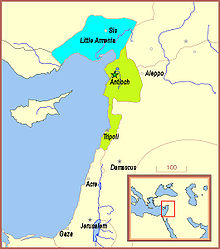
Back حرب الخلافة الأنطاكية Arabic Πόλεμος της Αντιοχικής Διαδοχής Greek Guerra de sucesión en el Principado de Antioquía Spanish جنگ جانشینی انطاکیه Persian Guerre de succession de la principauté d'Antioche French Անտիոքի ժառանգության համար պատերազմ Armenian Guerra di successione antiochena Italian د انطاکيه د ځايناستي جګړه Pashto/Pushto Война за антиохийское наследство Russian Antakya Halefiyet Savaşı Turkish
| War of the Antiochene Succession | |||||||||
|---|---|---|---|---|---|---|---|---|---|
 Kingdom of Cilicia, Principality of Antioch and County of Tripoli in the early 13th century | |||||||||
| |||||||||
| Belligerents | |||||||||
| Commanders and leaders | |||||||||
The War of the Antiochene Succession, also known as the Antiochene War of Succession, comprised a series of armed conflicts in northern Syria between 1201 and 1219, connected to the disputed succession of Bohemond III of Antioch. The Principality of Antioch was the leading Christian power in the region during the last decades of the 12th century, but Armenian Cilicia challenged its supremacy. The capture of an important fortress, Bagras, in Syria by Leo II of Cilicia gave rise to a prolonged conflict already in the early 1190s. Leo tried to capture Antioch, but the Greek and Latin burghers formed a commune and prevented the Armenian soldiers from occupying the town. Bohemond III's eldest son, Raymond, died in 1197, leaving an infant son, Raymond-Roupen. The boy's mother, Alice of Armenia, was Leo I's niece and heir presumptive. Bohemond III and the Antiochene noblemen confirmed Raymond-Roupen's right to succeed his grandfather in Antioch, but the commune preferred Bohemond III's younger son (Raymond-Roupen's uncle), Bohemond, Count of Tripoli.
Bohemond of Tripoli seized Antioch without resistance after his father died in April 1201, but many noblemen left the principality to seek refuge in Cilicia. Leo invaded the Principality of Antioch in almost every year between 1201 and 1208, but he had to return to his kingdom on each occasion because Az-Zahir Ghazi, the Ayyubid emir of Aleppo, or Kaykaus I, the Seljuq sultan of Rum stormed into Cilicia in his absence. Pope Innocent III initially supported Leo. However, the conflict between Leo and the Knights Templar over Bagras led to Leo's excommunication in 1208. During the following years, Leo captured new fortresses in Syria, abandoning them in 1213 as part of an effort to improve his relationship with the Holy See. Taking advantage of Bohemond IV's isolation, Leo entered Antioch, helping Raymond-Roupen seize the principality in 1216. Before long, Leo abandoned Bagras and lost the Armenian fortresses to the north of the Taurus Mountains to the Seljuqs. Raymond-Roupen increased taxes, which made him unpopular in Antioch. His relationship with Leo also became tense, enabling Bohemond IV to regain Antioch in 1219. The war contributed to the weakening of the Christian states in Northern Syria.
© MMXXIII Rich X Search. We shall prevail. All rights reserved. Rich X Search